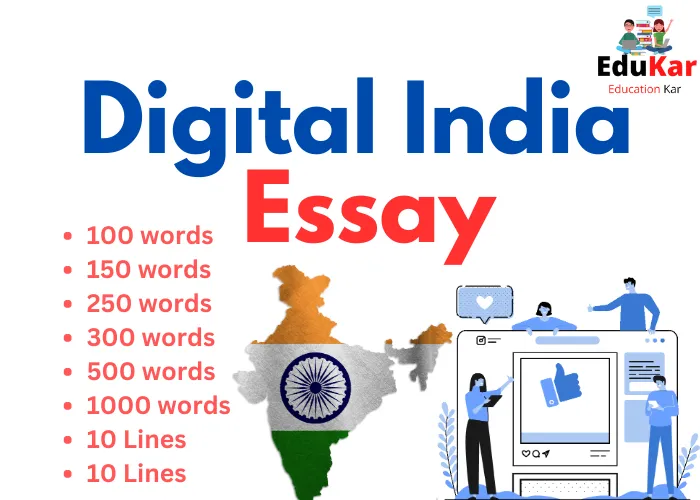Contents
Looking for an informative essay on the Digital India initiative? Read this collection of comprehensive Digital India Essay in 100, 150, 200, 250, 500 & 1000 words that explores the impact of digital technology on India’s economy, society, and governance. Discover how the government is promoting digital literacy, e-governance, and innovation to transform India into a knowledge-based society. Gain insights into the challenges and opportunities of digital transformation in India and its implications for the future.

Watch “Digital India Essay” on Youtbe
Digital India Essay 100 Words
Digital India is a program launched by the Indian government to transform India into a digitally empowered society and knowledge economy. The initiative aims to connect rural areas with high-speed internet, improve digital literacy, and create digital infrastructure across the country. It also focuses on promoting e-governance and online service delivery, enabling better healthcare and education, and fostering entrepreneurship and innovation. Through Digital India, the government aims to bring transparency and efficiency to its operations and improve citizen engagement. With the rapid growth of digital technology, Digital India is poised to make India a leading player in the global digital economy.
Digital India Essay 150 Words
Digital India is an initiative launched by the Indian Government to transform India into a digitally empowered society and knowledge economy. The campaign aims to provide accessible and affordable digital services to every citizen of India, regardless of their location.
The objectives of the Digital India campaign include the development of digital infrastructure, delivering government services electronically, promoting digital literacy, and creating a digitally inclusive society.
The program has brought about a digital revolution in India, with increased internet connectivity, the proliferation of mobile devices, and the growth of e-commerce. It has also enabled easier access to education and healthcare, improved communication and transparency in government processes, and boosted entrepreneurship.
However, there are still challenges that need to be addressed, such as the digital divide, inadequate digital infrastructure in rural areas, and cybersecurity threats. The Digital India campaign has made significant progress in transforming India into a digitally empowered society and knowledge economy.
Digital India Essay 200 Words

Digital India is a campaign launched by the Government of India in 2015 with the vision of transforming India into a digitally empowered society and knowledge economy. The goal of this initiative is to provide access to digital infrastructure, services, and information to every citizen of India.
The Digital India campaign focuses on three core areas: digital infrastructure, digital services, and digital literacy. The government aims to provide broadband connectivity to every citizen and make all government services available digitally. It also plans to promote digital literacy and skills development among citizens to enable them to take advantage of the digital economy.
Digital India has brought significant changes to the country, with the government launching various digital initiatives, such as Aadhaar, Digital Locker, e-Hospital, and many more. The campaign has made it easier for citizens to access government services and has also helped in the growth of the digital economy in India.
The Digital India campaign has played a crucial role in bridging the digital divide in the country, especially in rural areas. With the increase in internet penetration, more people have access to information and services, which has resulted in better economic opportunities and improved standards of living.
Digital India Essay 250 Words
Digital India is a flagship initiative of the Indian government aimed at transforming India into a digitally empowered society and knowledge economy. The initiative aims to bridge the digital divide between urban and rural areas by providing affordable access to digital services, enhancing digital literacy, and promoting the use of technology to improve governance and service delivery.
One of the key objectives of the Digital India initiative is to provide high-speed internet connectivity to all citizens, including those living in remote areas. This is being achieved through the rollout of the National Optical Fibre Network (NOFN), which aims to connect all 250,000 gram panchayats in the country. The initiative also aims to promote the use of mobile devices for accessing digital services, and several mobile applications have been developed to enable citizens to access government services such as healthcare, education, and banking.
Another important aspect of the Digital India initiative is the promotion of digital literacy. The government has launched several initiatives to enhance digital literacy, including the Digital Saksharta Abhiyan (DISHA) program, which aims to train 60 million people in digital literacy by 2020. The initiative also aims to promote the use of digital payments, with the goal of making India a cashless economy.
The Digital India initiative has already had a significant impact on the country, with the number of internet users in India increasing rapidly in recent years. The initiative has also helped to improve service delivery, with citizens now able to access government services online. The initiative has the potential to transform India into a leading digital economy, and the government is committed to continuing to invest in digital infrastructure and promoting the use of technology to improve governance and service delivery.
Digital India Essay 500 Words

Introduction
In 2015, the Indian government launched the Digital India initiative with the aim of transforming India into a digitally empowered society and knowledge economy. The initiative seeks to bridge the gap between citizens and technology by providing access to digital services and infrastructure across the country.
The Digital India initiative has several objectives, including the creation of digital infrastructure, the delivery of government services digitally, and the promotion of digital literacy among citizens. These objectives are being achieved through the implementation of various programs and initiatives that aim to improve access to digital services and infrastructure, as well as enhance the digital skills of citizens.
The initiative has several key components, including the establishment of a broadband network, the creation of digital public services, the promotion of digital literacy, and the development of a secure and stable digital infrastructure. The government is also working on promoting innovation and entrepreneurship in the digital space, and is encouraging the adoption of digital technologies in various sectors of the economy.
Benefits of Digital India
The benefits of the Digital India initiative are numerous. From an economic perspective, the initiative has the potential to drive growth and job creation by promoting innovation and entrepreneurship in the digital space. The initiative also seeks to promote financial inclusion by providing access to digital payment systems and services, thereby facilitating financial transactions and reducing the reliance on cash.
The initiative also has significant social benefits, particularly in rural areas where access to digital services and infrastructure is limited. Digital technologies can be used to improve access to healthcare and education, and can also be used to promote social inclusion and reduce inequalities.
In the education sector, the Digital India initiative has the potential to revolutionize the way education is delivered and accessed. By promoting digital literacy and providing access to digital educational resources, the initiative can help bridge the gap between urban and rural areas in terms of educational opportunities.
Challenges in implementing Digital India
One of the major challenges is the lack of digital infrastructure in certain parts of the country, particularly in rural areas. The government is working to address this challenge by expanding the broadband network and establishing digital service centers in rural areas.
Another challenge is the need to promote digital literacy among citizens, particularly in rural areas where digital literacy levels are low. The government is working to address this challenge by providing digital literacy programs and training for citizens, as well as promoting the use of digital technologies in education.
The issue of security and privacy concerns is another challenge that needs to be addressed. The government is working to establish a secure and stable digital infrastructure that is resistant to cyber threats and is also working to ensure that citizens’ privacy rights are protected.
Success stories of Digital India
Despite these challenges, there have been several success stories of the Digital India initiative. For example, the adoption of digital payment systems has increased significantly in recent years, reducing the reliance on cash and promoting financial inclusion. The government has also launched several e-governance initiatives that allow citizens to access government services digitally, thereby reducing bureaucracy and improving efficiency.
Future prospects of Digital India
The initiative seeks to bridge the gap between citizens and technology by providing access to digital services and infrastructure across the country. While there are challenges that need to be addressed, the benefits of the Digital India initiative are significant, and the government is working to ensure that the initiative is implemented effectively and efficiently. With continued investment and development, the Digital India initiative can help India achieve its full potential in the digital age.
Digital India Essay 1000 Words

Introduction
India has made significant strides in the digital sphere over the past decade. The Digital India initiative, launched in 2015, is a flagship program aimed at transforming India into a digitally empowered society and knowledge economy. The program aims to harness the power of digital technologies to bridge the digital divide, enhance access to digital services, and empower citizens and businesses to participate in the digital economy. This essay provides an overview of the Digital India initiative, its key components, and the impact it has had on India’s digital landscape.
Digital India Initiative
The Digital India initiative is a comprehensive program that aims to transform India into a digitally empowered society and knowledge economy. The program has three core components: digital infrastructure, digital governance, and digital services. The objectives of the initiative include the following:
- To provide universal access to digital services
- To create a digitally literate population
- To facilitate the creation of digital infrastructure
- To enable digital governance
- To promote digital empowerment of citizens
Key Components of the Digital India Initiative
The Digital India initiative comprises several key components that are critical to its success. These include:
1. Digital Infrastructure: The digital infrastructure component aims to create a robust digital backbone that enables the delivery of digital services to citizens and businesses. This includes initiatives such as the BharatNet project, which aims to connect all villages in India with high-speed broadband. Under this initiative, over 400,000 villages have been connected to broadband networks, providing access to digital services to millions of people.
2. Digital Governance: The digital governance component aims to digitize government services, making them more accessible, efficient, and transparent. The program includes initiatives such as the National e-Governance Plan (NeGP), which aims to provide electronic delivery of government services to citizens. Under this initiative, over 2,500 government services have been digitized, making them accessible to citizens through various channels, including mobile devices and kiosks.
3. Digital Services: The digital services component aims to provide a wide range of digital services to citizens and businesses. This includes initiatives such as the Digital Locker, which enables citizens to store and share important documents online securely. The program also includes initiatives such as the DigiLocker, which enables citizens to store and share important documents online securely.
Benefits of the Digital India Initiative
The Digital India initiative has had several benefits for citizens, businesses, and the economy. Some of the key benefits include:
1. Improved access to digital services: The Digital India initiative has significantly improved access to digital services for citizens and businesses. With the implementation of various digital initiatives, citizens and businesses can now access government services, financial services, and other digital services with ease.
2. Increased efficiency: The Digital India initiative has improved the efficiency of government services, making them more accessible, efficient, and transparent. The digitization of government services has reduced the time and cost involved in accessing these services, resulting in increased efficiency and productivity.
3. Boost to the digital economy: The Digital India initiative has helped boost the digital economy by enabling businesses to leverage digital technologies to improve their operations and reach a wider audience. With the implementation of digital infrastructure and digital services, businesses can now access new markets and customers, resulting in increased revenue and growth.
4. Enhanced digital literacy: The Digital India initiative has helped enhance digital literacy among citizens, making them more aware of the benefits of digital technologies. With the implementation of various digital initiatives, citizens can now access digital services with ease, resulting in increased awareness and adoption of digital technologies.
Digital Infrastructure in India
Digital infrastructure is critical to the success of the Digital India initiative. India has made significant progress in this regard, with the BharatNet project being a key component of the digital infrastructure. The project aims to connect all villages in India with high-speed broadband, providing access to digital services to millions of people. In addition, the government has also launched several other initiatives to improve digital infrastructure, such as the National Optical Fibre Network (NOFN), which aims to provide high-speed broadband connectivity to government institutions, and the National Knowledge Network (NKN), which aims to connect universities and research institutions with high-speed broadband.
The improvements made under the Digital India initiative have had a significant impact on India’s digital infrastructure. The availability of high-speed broadband has helped bridge the digital divide, providing access to digital services to millions of people who previously had limited or no access to such services. In addition, the availability of high-speed broadband has also helped improve the delivery of government services, making them more accessible, efficient, and transparent.
Challenges and Future Outlook of Digital India
The implementation of the Digital India initiative has not been without challenges. One of the key challenges faced by the program is the lack of digital literacy among citizens. While the program has helped enhance digital literacy among citizens, there is still a long way to go in terms of making citizens fully digitally literate.
Another challenge faced by the program is the lack of digital infrastructure in certain parts of the country. While significant progress has been made in terms of digital infrastructure, there are still several areas that do not have access to high-speed broadband, which is critical to the success of the Digital India initiative.
Despite the challenges, the future outlook for the Digital India initiative is positive. The government has taken several measures to address the challenges faced by the program, such as launching initiatives to enhance digital literacy and improve digital infrastructure. With continued investments in digital infrastructure and digital services, India is well-positioned to become a leading player in the digital economy.
Digital India Essay 10 Lines
- Digital India aims to create digital infrastructure, provide digital literacy, and deliver digital services to all citizens of India.
- Digital India aims to provide universal access to the internet to all citizens and promote digital literacy to enable them to access and use digital services.
- The program has a goal to provide digital identity to every Indian citizen through the Aadhaar card, a biometric-based identification system.
- The program aims to connect all villages and cities in India with high-speed broadband networks, and promote the use of digital technologies in every aspect of life.
- The program has introduced various digital services such as Digital Locker, e-Hospital, e-Sign, and e-Scholarship, among others, to enable citizens to access government services online.
- Digital India has launched various initiatives to promote entrepreneurship and innovation in the digital sector, such as the Start-up India and Digital India Innovation Fund.
- The program has also launched various initiatives to promote the use of digital technologies in education and skill development, such as the National Digital Literacy Mission and the Skill India program.
- The program has set up the National Optical Fibre Network (NOFN) to connect all 2.5 lakh Gram Panchayats (village councils) with high-speed broadband connectivity.
- The program aims to promote digital payment systems such as the Unified Payments Interface (UPI) and promote the use of digital transactions to reduce cash transactions in the economy.
- Digital India is expected to have a transformative impact on the Indian economy by creating new digital opportunities, increasing efficiency and productivity, and promoting innovation and entrepreneurship in the country.
Digital India Essay 20 Lines
- Digital India is a flagship program launched by the Government of India in 2015.
- It aims to transform India into a digitally empowered society and knowledge economy.
- The program envisions creating a digitally literate population that can access digital services.
- Digital India aims to provide affordable and accessible digital infrastructure to all.
- The program also aims to promote digital entrepreneurship and innovation in the country.
- The program focuses on three key areas: digital infrastructure, digital literacy, and digital services.
- Digital infrastructure includes the development of high-speed broadband networks and mobile connectivity.
- Digital literacy aims to provide basic digital skills to every citizen, particularly in rural areas.
- Digital services include a range of e-governance services and online platforms for citizens.
- Digital India has several flagship initiatives, such as BharatNet, Common Service Centres, and Digital Locker.
- BharatNet aims to provide high-speed broadband connectivity to over 250,000 gram panchayats.
- Common Service Centres (CSCs) are a network of digital access points for delivering government services.
- Digital Locker provides citizens with a secure online repository for storing their documents and certificates.
- The program has been successful in promoting digital payments and cashless transactions in the country.
- Digital India has played a critical role in promoting e-commerce and online business in India.
- The program has also facilitated the growth of the start-up ecosystem in India.
- Digital India has created new employment opportunities in the IT and digital sectors.
- The program has helped in improving the quality of education and healthcare in rural areas.
- Digital India has made government services more accessible and efficient for citizens.
- The program has helped in bridging the digital divide between urban and rural areas, and between different sections of society.
















